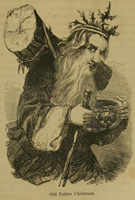Pagan Origins
Dating back centuries before Christ, cultures brought evergreen trees, plants, and leaves into their homes upon the arrival of the winter solstice, which occurs in the northern hemisphere between December 21st and 22nd. Although the specific practices were different in each country and culture, the symbolization was generally the same: to celebrate the return of life at the beginning of winter's decline.
 Egyptians particularly valued evergreens as a symbol of life's victory over death. They brought green date palm leaves into their homes around the time of the winter solstice.
Egyptians particularly valued evergreens as a symbol of life's victory over death. They brought green date palm leaves into their homes around the time of the winter solstice.
 Romans had a public festival called Saturnalia, which lasted one week beginning on December 17th, and included a variety of celebrations around the winter solstice. Curiously, the Roman winter solstice was marked on December 25th on the Julian calendar. These celebrations are thought to have merged with pagan practices of hanging mistletoe and the burning of the Yule log.
Romans had a public festival called Saturnalia, which lasted one week beginning on December 17th, and included a variety of celebrations around the winter solstice. Curiously, the Roman winter solstice was marked on December 25th on the Julian calendar. These celebrations are thought to have merged with pagan practices of hanging mistletoe and the burning of the Yule log.

 In Britain, the Yule log was originally seen as a magical amulet, and eventually made it into the hand's of Father Christmas. In Italy the Yule log is still burned for the "Festa di Ceppo". In Catalonia, the log is wrapped in a blanket until Christmas Eve, when it's unwrapped and burned for the custom of "fer cagar el tio". And in Serbia, families bring the Yule log (known as a "badnjak") into their homes on Christmas Eve to be burned along with prayers to God to bring happiness, luck, and riches.
In Britain, the Yule log was originally seen as a magical amulet, and eventually made it into the hand's of Father Christmas. In Italy the Yule log is still burned for the "Festa di Ceppo". In Catalonia, the log is wrapped in a blanket until Christmas Eve, when it's unwrapped and burned for the custom of "fer cagar el tio". And in Serbia, families bring the Yule log (known as a "badnjak") into their homes on Christmas Eve to be burned along with prayers to God to bring happiness, luck, and riches.
 Druid priests in Great Britain also used evergreen plants and mistletoe in pagan ceremonies, and the mistletoe plant was the symbol of the birth of a god. Celtic Druids and Norseman of Scandinavia also used mistletoe in a mysterious ceremony just after the winter solstice.
Druid priests in Great Britain also used evergreen plants and mistletoe in pagan ceremonies, and the mistletoe plant was the symbol of the birth of a god. Celtic Druids and Norseman of Scandinavia also used mistletoe in a mysterious ceremony just after the winter solstice.
 In the mid 1500's, Germans began using evergreen trees as a symbol of hope for the coming of spring. This practice is likely to have gradually evolved from pagan rituals of past, and merged with the celebration of Christmas leading to the tree's Christian beginnings.
In the mid 1500's, Germans began using evergreen trees as a symbol of hope for the coming of spring. This practice is likely to have gradually evolved from pagan rituals of past, and merged with the celebration of Christmas leading to the tree's Christian beginnings.
